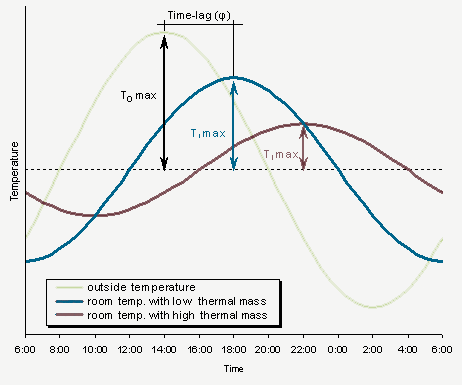thermal mass

The influence of thermal mass on the periodic heat flow. The diurnal variations of the outside temperature (green line) result in heat flows into the building during the day, where part of the heat is stored in the material. During the night, the heat flow is reversed (from the building to the environment). The resulting diurnal variations of the indoor temperature vary between low thermal mass (blue line) and high thermal mass (red line). The higher the thermal mass, the greater the time lag and the smaller the decrement factor between the variation of internal and external temperatures (Timax/Tomax). Thus thermal mass leads to increased thermal comfort and to reduced peak loads for technical systems.
Thermal mass is the ability of a material or structure to absorb heat energy. The thermal mass, or heat storage capacity, of structures affects the dynamical thermal behavior of a building.
High density materials such as concrete, bricks, and tiles require a great deal of heat energy to change their temperature and are therefore said to have high thermal mass. Lightweight materials, on the other hand, such as timber, have low thermal mass.
Thermal mass is particularly beneficial where there is a big difference between day and night outdoor temperature. Appropriate use of thermal mass moderates internal temperatures by averaging day and night (diurnal) extremes, which in turn improves comfort and reduces energy costs.
Thermal mass acts as in the same way as a battery, except that is stores heat instead of electricity. During summer it absorbs heat, keeping a building comfortable. In winter the same thermal mass can store the heat from the sun or heaters to release it at night, helping the building stay warm. However, thermal mass is not a substitute for insulation. Thermal mass stores and re-radiates heat. Insulation stops heat flowing into or out of the building. A high thermal mass material is not generally a good thermal insulator.
